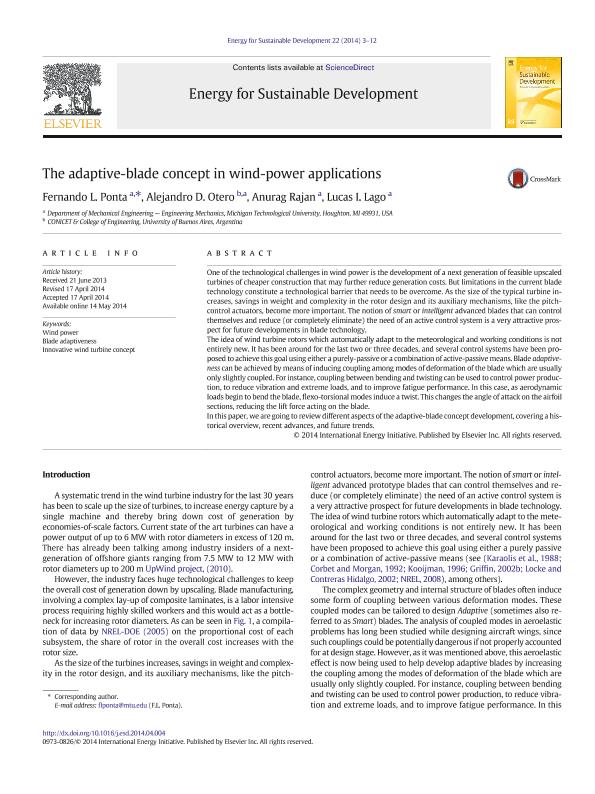Mostrar el registro sencillo del ítem
dc.contributor.author
Ponta, Fernando Luis

dc.contributor.author
Otero, Alejandro Daniel

dc.contributor.author
Rajan, Anurag
dc.contributor.author
Lago, Lucas Ignacio

dc.date.available
2017-12-26T20:08:06Z
dc.date.issued
2014-10
dc.identifier.citation
Rajan, Anurag; Lago, Lucas Ignacio; Otero, Alejandro Daniel; Ponta, Fernando Luis; The adaptive-blade concept in wind-power applications; Elsevier; Energy for Sustainable Development; 22; 10-2014; 3-12
dc.identifier.issn
0973-0826
dc.identifier.uri
http://hdl.handle.net/11336/31592
dc.description.abstract
One of the technological challenges in wind power is the development of a next generation of feasible upscaled turbines of cheaper construction that may further reduce generation costs. But limitations in the current blade technology constitute a technological barrier that needs to be overcome. As the size of the typical turbine increases, savings in weight and complexity in the rotor design and its auxiliary mechanisms, like the pitch-control actuators, become more important. The notion of smart or intelligent advanced blades that can control themselves and reduce (or completely eliminate) the need of an active control system is a very attractive prospect for future developments in blade technology.
The idea of wind turbine rotors which automatically adapt to the meteorological and working conditions is not entirely new. It has been around for the last two or three decades, and several control systems have been proposed to achieve this goal using either a purely-passive or a combination of active-passive means. Blade adaptiveness can be achieved by means of inducing coupling among modes of deformation of the blade which are usually only slightly coupled. For instance, coupling between bending and twisting can be used to control power production, to reduce vibration and extreme loads, and to improve fatigue performance. In this case, as aerodynamic loads begin to bend the blade, flexo-torsional modes induce a twist. This changes the angle of attack on the airfoil sections, reducing the lift force acting on the blade.
In this paper, we are going to review different aspects of the adaptive-blade concept development, covering a historical overview, recent advances, and future trends.
dc.format
application/pdf
dc.language.iso
eng
dc.publisher
Elsevier

dc.rights
info:eu-repo/semantics/openAccess
dc.rights.uri
https://creativecommons.org/licenses/by-nc-sa/2.5/ar/
dc.subject
Wind Power
dc.subject
Blade Adaptiveness
dc.subject
Innovative Wind Turbine Concept
dc.subject.classification
Ingeniería Mecánica

dc.subject.classification
Ingeniería Mecánica

dc.subject.classification
INGENIERÍAS Y TECNOLOGÍAS

dc.title
The adaptive-blade concept in wind-power applications
dc.type
info:eu-repo/semantics/article
dc.type
info:ar-repo/semantics/artículo
dc.type
info:eu-repo/semantics/publishedVersion
dc.date.updated
2017-12-11T15:02:55Z
dc.journal.volume
22
dc.journal.pagination
3-12
dc.journal.pais
Estados Unidos

dc.description.fil
Fil: Ponta, Fernando Luis. Michigan Technological University; Estados Unidos
dc.description.fil
Fil: Otero, Alejandro Daniel. Michigan Technological University; Estados Unidos. Consejo Nacional de Investigaciones Científicas y Técnicas; Argentina
dc.description.fil
Fil: Rajan, Anurag. Michigan Technological University; Estados Unidos
dc.description.fil
Fil: Lago, Lucas Ignacio. Michigan Technological University; Estados Unidos
dc.journal.title
Energy for Sustainable Development
dc.relation.alternativeid
info:eu-repo/semantics/altIdentifier/url/http://www.sciencedirect.com/science/article/pii/S0973082614000325
dc.relation.alternativeid
info:eu-repo/semantics/altIdentifier/doi/http://dx.doi.org/10.1016/j.esd.2014.04.004
Archivos asociados
